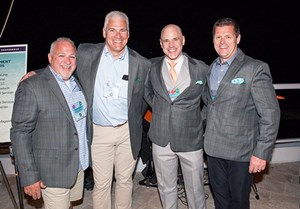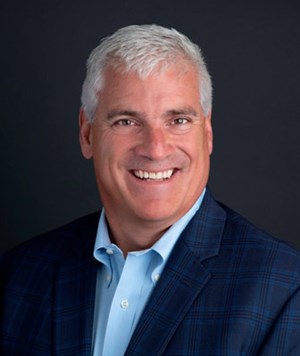December 2023 Vol. 78 No.11
Features
Tim Vivian, NASSCO Standard Bearer
EDITOR’S NOTE: NASSCO continues to set standards for the assessment and rehabilitation of underground infrastructure. A vast array of individuals has contributed to the success of the association, both in the past and present, that has driven NASSCO’s industry mission. This series of articles recognizes those who have not only been critical to the success of NASSCO, but the industry as well.
This month, we profile Tim Vivian, a remarkable leader for NASSCO who has been instrumental in aiding the amazing growth of the association through various challenges, all while recognizing and maximizing opportunities.
I grew up part of a blue-collar family in New Canaan, Conn., a very well-to-do community. Dad worked for the power company as an electrician while Mom worked at home raising my two older brothers, two younger sisters, and me. My parents were great providers and we never lacked for anything, but living in such a prosperous community, at times, created a feeling of not fitting in.
Because of my dad’s career, I was lucky to be around construction from a very early age. By the time I was 10 years old I started going to job sites with him where I learned the value of hard work. Unfortunately, he passed away in 1978, when I was a freshman in high school. While my hands-on training was cut short, the die had been cast – I loved working with my hands, and I wasn’t afraid to get dirty.
Due to the investment my dad made in me during a very formative stage of my life, throughout my high school years I sought out labor jobs, such as cutting grass or supplying firewood to friends and neighbors, and eventually found my way working as a carpenter’s assistant. I kept that job throughout high school and college and even a year after I graduated.
My lacrosse skills helped me gain entry to Cornell University, but choosing a major was not as easy. I always thought of myself as an English or history kind of guy. Then I thought a career in law was where I wanted to focus, but at the end of the day I didn’t do great on the LSATs; I just didn’t have the passion it would take to become a lawyer.
Plus, by that time I was already dating Kristen, who was soon to be my wife. Family was my top priority, so instead of continuing my education after graduation, I took my degree in history and moved on.
After working as a carpenter during my first year out of college, I took a job with Capital Sports, a sports marketing company. In the late 1980s and early 1990s sports marketing companies were very popular. Major corporations were putting a lot of money into sports sponsorships.
One of those sponsors was my client, Equitable Life Insurance, who sponsored Old-Timers games in every major-league ballpark. I traveled every weekend in the summer to run the program and manage the games. It was fun for a 22-year-old person who had never traveled much in his life, but it was also difficult because by that time Kristen and I were married, and I hated leaving her at home week after week.
Changing course
After three years with Capital Sports, Steve Paletta, a friend and fellow lacrosse teammate from Cornell, called and asked if I’d like to join him and his brother Mike who were starting their own construction company, Westmoreland Construction.
This was the spring of 1991. I was more than ready to make a change, and I loved it. No two days were ever the same for me. One day I would be in a trench, the next day in the office. I felt like I was finally back where I belonged, in construction. The seed my dad planted when I was just a kid had finally taken root.
That year was also when I met Dave Fletcher, who first introduced me to NASSCO. Dave and Steve were high-school friends and Dave was providing U-Liner (fold and form) technology to Westmoreland Construction through his work with Midwest Pipeliners, an Ohio company formed by Kathy Hammer.
Later that year, Dave moved back to Connecticut where he, Steve and I started a new company, Pipelining Products. We developed our own fold-and-form lining process using HDPE pipe. That was my first real introduction to trenchless technology.
Dave quickly sold an 18-inch lining job to Ann Arundle County, Md., and we got the work done. We now had a track record, and one job led to another. The company started to grow, and we needed good people. Dave had many industry contacts in Ohio, and we hired Hank Hultz, a former salesperson for Insituform with an impressive rolodex of clients. He helped us get the work and we figured out – sometimes in real-time – how to do it.
Looking back, there was one job, in particular, that to this day amazes me because of our lack of awareness of what we were getting ourselves into. Located about an hour outside of New York City, assessing the town’s disordered underground infrastructure footprint was like playing a board game. We weren’t sure where the next move was going to take us. We basically had to follow the “learn-as-you-go” method of rehabilitating pipe, but surprisingly, the project was a success.
During these early days of trenchless in the United States, companies like ours really benefited from NASSCO membership because of the shared mission to set standards and build awareness of trenchless technologies. Dave was very involved in NASSCO and served as president of the Board of Directors from 2004-2005.
Gil Carroll joined Pipelining Products in the winter of 1994, and we designated him the “NASSCO guy,” attending all NASSCO meetings and participating in NASSCO Committees on our behalf. I wasn’t personally involved in NASSCO during those years, as I was busy filling many roles including sales, project manager and plant manager.
The first NASSCO Annual Conference I attended was in Florida in 2002, and I have attended every conference ever since. After a few years of involvement, Marc Anctil asked me why I attended all the meetings but didn’t sit on the board. Before I knew it, Marc had nominated me to fill a contractor seat and I was elected to the board in 2010.
I remember many of the board meeting conversations surrounding PACP. I had no idea what they were talking about, but soon learned the value that PACP brings to our industry through consistent and accurate coding of underground conditions. I stayed on the board for many years, eventually serving as president from 2018-2019.

New opportunities
In 1995 Insituform’s patents ran out and Pipelining Products jumped feet-first into the market with a cured-in-place pipe (CIPP) system. The company, like many others offering CIPP during the early years of adoption, experienced many ups and downs in providing trenchless rehabilitation.
Dave left in 1997 to work for Applied Felts, a manufacturer of felt liners used in the process, and I stayed until 2003 when the company decided to cease operations. Brent Ketner, Corey Sterns, Mike Melanson and I saw the opportunity to start another business, Green Mountain Pipeline Services. I wrote a business plan, we got insurance, found a bank, used our severance from Pipelining Products to fund the business and – in my typical fashion – we jumped right in to do the work.
Brent, Corey and Mike were operations field guys, while I served as president and handled business development. Green Mountain Pipeline Services flourished, and today we offer a full spectrum of services including CCTV inspection, pipe lining and rehabilitation, manhole restoration, cleaning and maintenance, grouting and sealing, stormwater management and SSES field work.
Mike left in 2007 and the remaining partners sold the majority of its equity in 2018. Today Corey and I are the two remaining founders and value our NASSCO membership more than ever. The ability to have a voice in setting standards, access to peer-reviewed specification guidelines, participation in educational events, and networking with industry leaders continues to support the ongoing growth of Green Mountain Pipeline Services.
While companies like ours receive many benefits from NASSCO membership, I find it equally important to give back to the association, and our industry. Participation in NASSCO committees and serving on the board of directors are two great ways to do that.
During my tenure on the board, I had the privilege to travel to the United Kingdom to meet with WRc and discuss ways to partner globally. NASSCO’s PACP was built on WRc’s Manual Sewer Condition Classifications, or MSCC.
Since launching PACP in 2002, NASSCO has paid royalty fees to WRc for use of the codes. After ongoing discussions with WRc, last April, NASSCO was successful in negotiating a perpetual license agreement for all PACP intellectual property in our territories, opening up even more opportunity for growth of the program.
In addition to PACP, which has seen nearly 40,000 individuals certified since 2002, NASSCO also offers Inspector Training Certification Programs (ITCP) in CIPP and manhole rehabilitation technologies. With a learning management system firmly in place, NASSCO now has self-paced, online courses in CIPP and grouting safety, with the development of certification programs in drain cleaning, asset management and other subjects on the horizon.
My hope for the future of NASSCO is that it continues to develop these training and education programs to reach as many people as possible, with setting high standards in the work that we do being our ultimate goal.





Comments